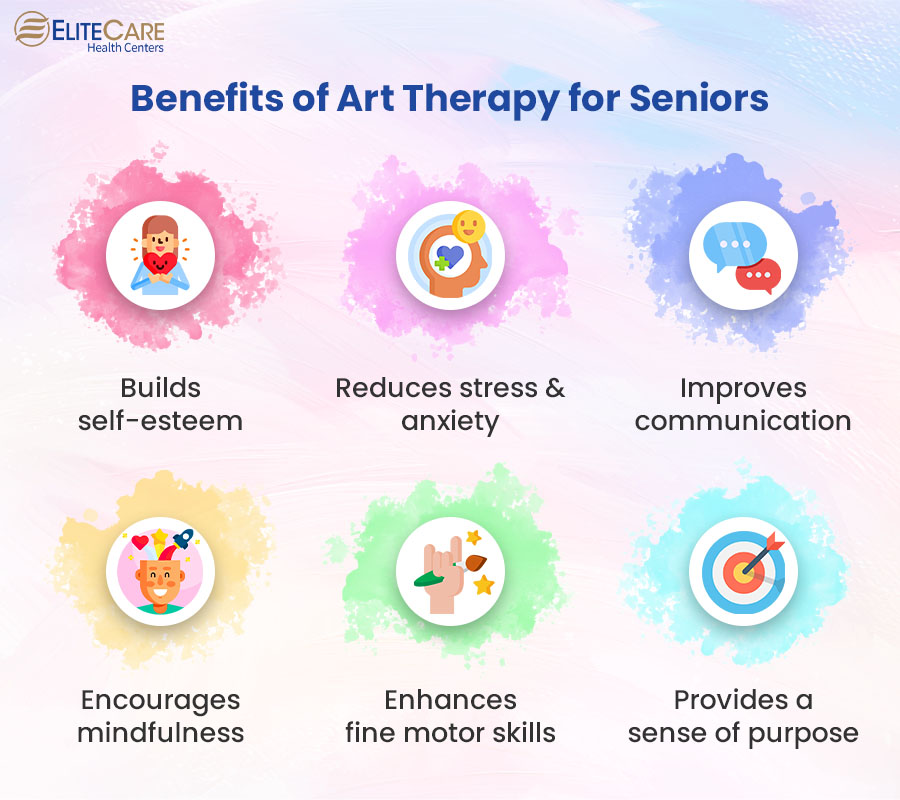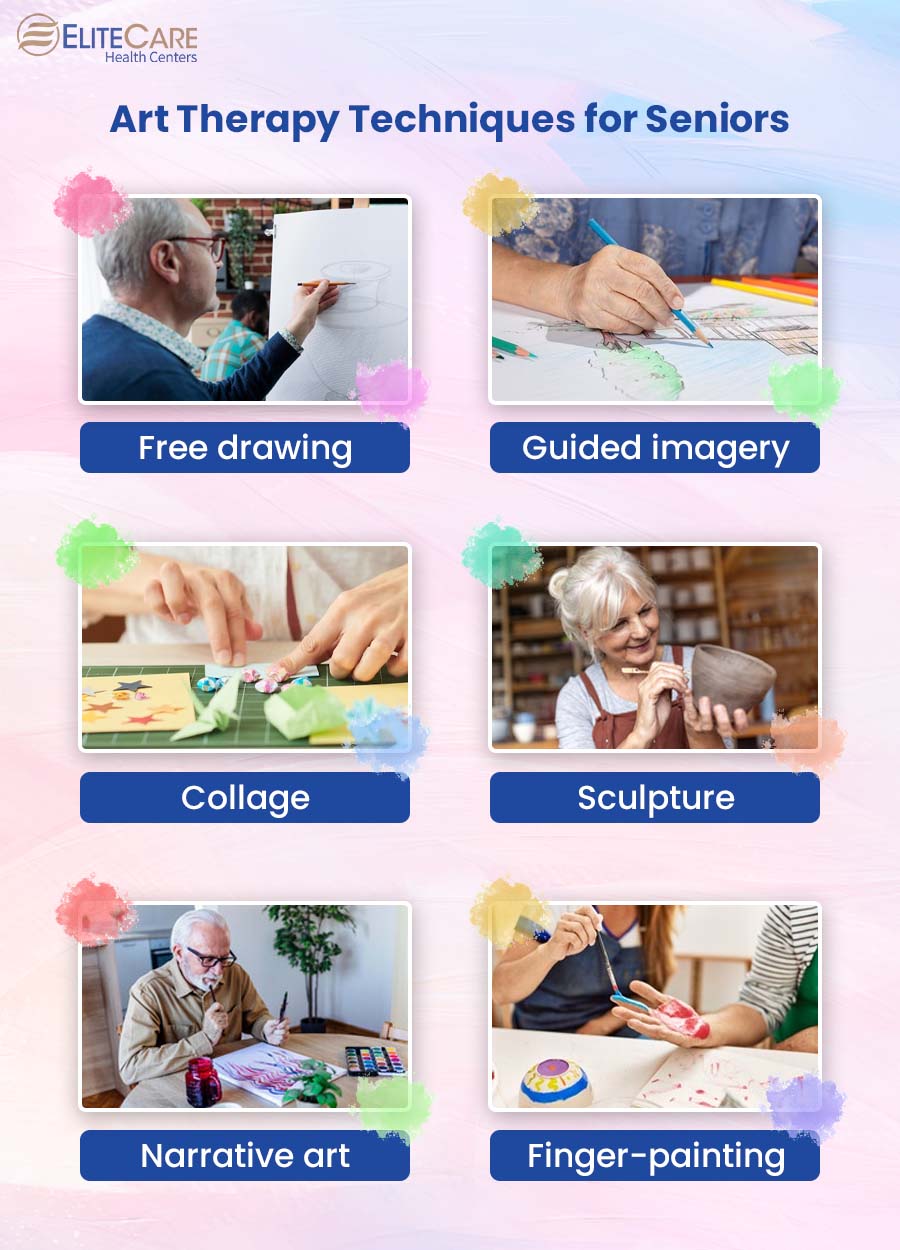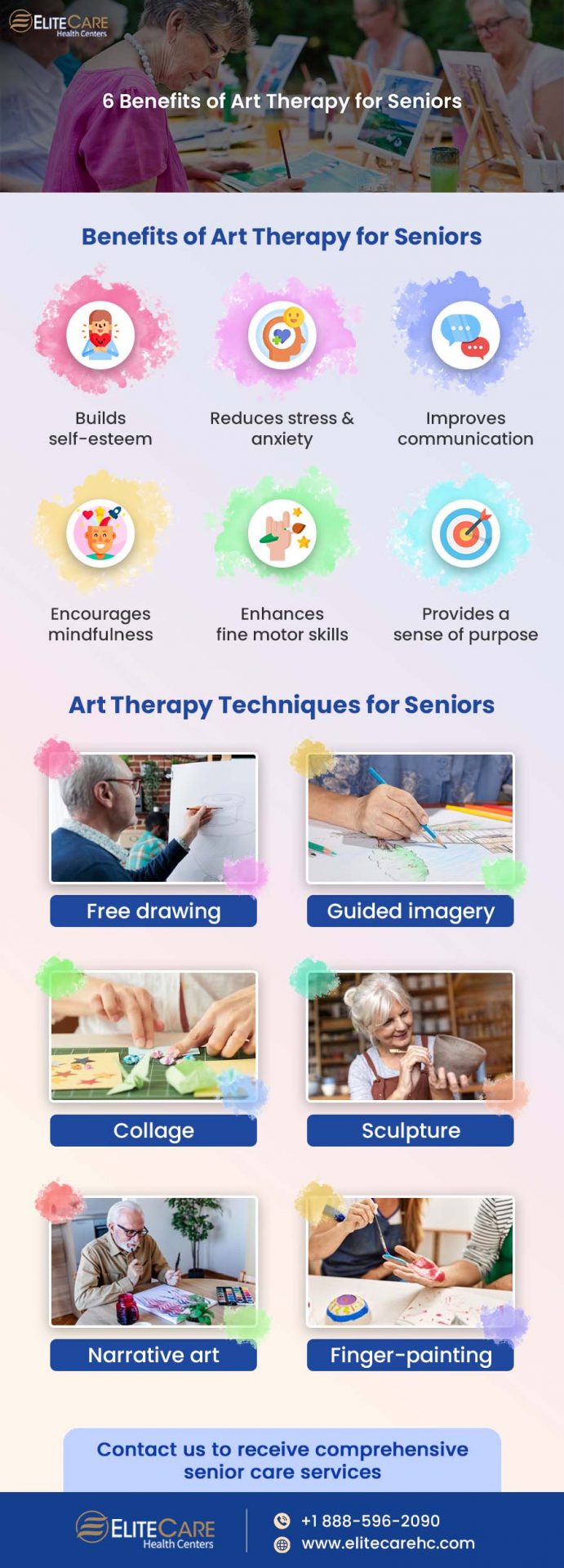
Art therapy is an alternative therapy option that uses artmaking as a tool for self-expression and healing. It involves the use of a variety of art materials and techniques to facilitate communication and explore emotions and thoughts through art creation.
Seniors are often on multiple medications due to various age-related health issues. Alternative therapies like art therapy can be especially beneficial for them as they are non-invasive, don’t require any stressful visits to medical clinics, and have zero side effects. Therefore, primary care physicians have been putting more focus on alternative therapies for the past few years.
What are the benefits of art therapy for seniors, what are the techniques available for them or how can they get started with it? Read on to learn more.
Benefits of Art Therapy for Seniors

Art therapy has numerous benefits for seniors, including physical, emotional, and social benefits. The following are some specific benefits of art therapy for adults:
Enhances self-awareness and self-esteem
Through the creative process of art therapy, seniors can explore their thoughts, feelings, and experiences in a non-judgmental and supportive environment. It can eventually lead to a greater understanding and acceptance of oneself, as well as an improved sense of self-worth and confidence.
A study revealed that seniors who participated in a 12-week art therapy program reported increased self-esteem and feelings of empowerment.
Reduces stress and anxiety
Engaging in creative activities like painting, drawing, coloring or doodling can be a relaxing and meditative experience, creating a sense of calmness and tranquility. That is why art therapy is now being widely recommended by primary care physicians as a tool to manage stress and improve mental health in adults.
Read More: Importance of Mental Health of Seniors
Improves communication
Art therapy can be especially helpful for seniors struggling with verbal communication. Through the use of visual imagery, seniors can express themselves and communicate their thoughts and feelings in a non-verbal and creative way.
Besides, it also helps seniors to be a part of a community of art enthusiasts and provides them with a channel to make social connections.
Encourages mindfulness
Art therapy can encourage seniors to practice mindfulness, which involves being present at the moment and focusing on the present experience. The act of creating art can be a meditative experience since it allows individuals to enter a state of flow or “being in the zone,” where they are fully engaged in the present moment. It can help seniors shift their attention away from ruminating thoughts or worries and bring them into a state of calm and relaxation.
Moreover, the process of creating art can be an opportunity for self-reflection and non-judgmental exploration of their own thoughts. Therefore, it can help individuals cultivate a sense of mindfulness and develop a deeper understanding of themselves.
Improves fine motor skills
Activities such as drawing, painting, and sculpting require precise movements and involve coordinated movement of small muscles in the hands and fingers. Therefore, it can improve their hand-eye coordination, finger dexterity, and overall fine motor control. It can help them perform daily tasks such as writing, buttoning clothes, and using utensils with ease.
Provides a sense of purpose
Art therapy can provide seniors with a sense of purpose and meaning, which can be particularly important for those who may live alone and feel isolated or lonely. Creating art can provide a sense of accomplishment and a feeling of creating something meaningful.
Art Therapy Techniques for Seniors

Art therapy uses a range of techniques to help seniors explore their emotions and experiences through the creative process. Here are some common techniques used in art therapy for seniors:
1. Free drawing
It is a form of art therapy where seniors are encouraged to draw whatever comes to their minds without any guidance. Free drawing can help seniors explore their feelings and gain a better understanding of themselves and their feelings.
2. Guided imagery
This technique combines the use of visual imagery and creative thinking to promote healing and personal growth. In this process, the therapist will use descriptive words to guide seniors through a visualization exercise that will involve closing their eyes and imagining a peaceful place or a positive outcome to a specific situation.
After the visualization exercise, seniors are generally asked to create art that represents the experience. This may involve drawing, painting, or working with other materials such as clay or collage.
3. Collage
In this form of art therapy, seniors create a composition by assembling various elements such as photographs, fabric, paper, and other materials.
4. Sculpture
Through this technique, seniors create three-dimensional objects out of various materials such as clay, wood, metal, and other materials.
5. Narrative art therapy
This is a form of art therapy where seniors tell a story through visual arts such as drawing and painting. The therapist first completes the assessment and asks seniors to create a story based on a specific prompt or incident.
Once seniors explore the themes, emotions, and experiences that emerge through the storytelling process, they can begin with the art-making process, using a variety of art materials.
6. Finger-painting
This form of art therapy involves the use of bare fingers to create an image on paper or canvas. It is a fun and playful form of art therapy that helps individuals, including seniors, express themselves creatively and explore their emotions and experiences in a safe and supportive space.
Getting Started With Art Therapy
Keep an open mind
The first step to getting the most out of art therapy is to keep an open mind and be willing to try new things. Art therapy can be a powerful tool for seniors to improve their cognitive health, but it requires a willingness to engage in the process.
Set realistic expectations
Seniors should have realistic expectations for themselves and from the art therapy process. The primary focus of art therapy is on the process of creating and expressing oneself, rather than on creating a perfect or finished piece of art.
Start small
Discuss the options with the therapist in detail and start with simple exercises or materials and gradually shift towards more complex projects.
Focus on your emotions
Art therapy is a tool for exploring and expressing one’s emotions and thoughts. Seniors should focus more on how they are feeling and use art as a way to express those emotions.
Choose materials that suit your needs
Talk to the therapist and choose the materials that are easy to use, such as large brushes or finger paints. Individuals with limited mobility or dexterity should consider their painting or art tools carefully for ease of effort and creation.
Consult a qualified art therapist
It is crucial to seek out a qualified art therapist who has specialized training in working with seniors. They can guide seniors through the process and provide support and guidance along the way.
Conclusion
Art therapy can be an effective and beneficial form of alternative therapy for seniors to improve their mental health and overall well-being. It is a non-invasive therapy that can be easily adapted and personalized to meet the unique needs and abilities of each senior. It can also work as a great social activity to combat feelings of loneliness and isolation.
Seniors should consult their primary care physicians before they opt for this therapeutic alternative treatment procedure. For any queries or concerns, contact EliteCare HC, one of the best medical clinics and healthcare centers in Florida that provides senior care services. Visit your nearest center or call us to book an appointment with our board-certified providers.






